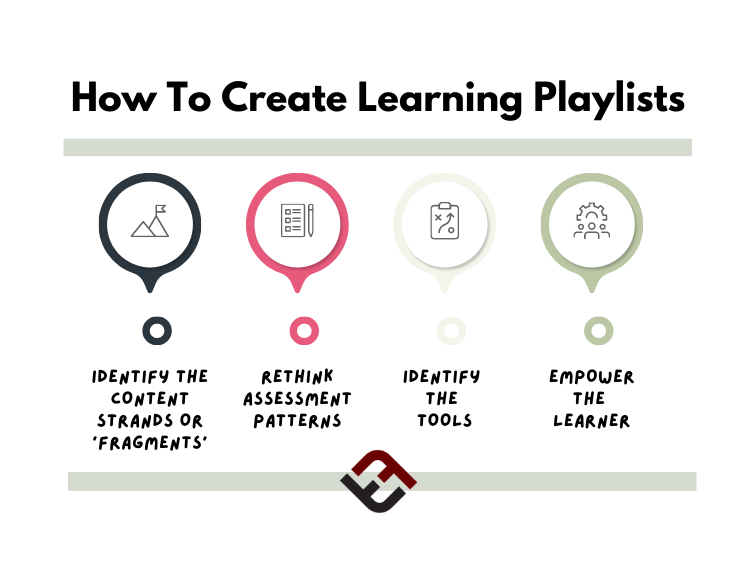
How To Create Learning Playlists
by Terry Heick
The idea of playlists became popular with the explosion of iTunes and YouTube in the last decade.
Before music became digital, it was bound by its physical restrictions. Record players required users to pick up and move the needle, cassette players forced users to rewind or fast-forward to certain songs (the humanity), and even CD players simply accelerated this process by allowing for faster track selection, and faster moving across and within tracks.
With digital music, listeners could not only move more quickly between songs but could cherry-pick them from certain ‘albums’ to listen to. And in any order they wanted. Digital music was still only music, but its formless nature made it infinitely malleable.
No longer were users bound to listen to an entire record, or to create homemade cassettes. With digital music, unique playlists were now possible.
YouTube further allowed community playlists to be created, where users could create a rotation of songs that others could listen to. This allowed new music to be discovered—made listening social before Spotify, YouTube, and others started to pick up steam there, and eased the burden of hand-selecting the songs yourself if you were in a rush. The crowd steps in to lend a hand.
So what if, in a world of textbooks or overpriced and mediocre ‘personalized learning software’–we did the same thing with learning? An array of platforms have already recognized the potential here, allowing for pathways through content to be determined ahead of time by experts—or at least experienced users of that content. This essentially made the ‘cherry-picking’ social.
In formal education, things are obviously a bit different, but not really. The content is the music. The learning network of peers is the crowd. Educators are experts in resources and assessment, providing feedback loops to help inform learning results.
And communities become audiences for the music.
With modern digital and social technology, learning playlists are now possible. Each learner has access to both the content and the tools to consume content in an order that is within their unique Zone of Proximal Development, cultural schema, and personal interest.
So how might this work?
4 Steps For Creating Learning Playlists
1. Identify the content strands or ‘fragments’
The first step here is that an established curriculum—content in some sequence, with some inherent priority—is taken apart like puzzle pieces. Once in fragments, it can then be meaningfully reassembled based on personalized learning needs: learner interest, prior/background knowledge, reading level, and (diverse) assessment results. In K-12 in the United States, curriculum is already ‘broken’ into learning standards—or rather educators and curriculum designers take said standards and try to mold them into some compelling personal narrative that users will hopefully want to consume.
But the data teams, assessment results, and even in-class differentiation are informed via proficiency in individual—and fragmented—standards.
2. Rethink assessment patterns
Once curriculum is broken apart into a playlist that is personalized, there needs to be some method for that playlist to be revised—added to, subtracted from, or reordered based on a variety of factors. If the playlist is static, it’s little better than a pre-formatted, one-size-fits-all curriculum.
If assessment is just a tool to think of how to alter such playlists, it itself can be designed with this in mind, likely more frequent, more flexible, and more transparent to all members of the learning process. Only those with access to ‘mastery results’ are suitably informed to make such decisions, and in the past this has been a single, overworked classroom teacher.
3. Identify the tools
This could arguably be the first step–it depends if you want to work backward from content and students or tools and platforms. There truth is, there is no ‘right’ answer. Choose whichever makes more sense to you and go with it. You can always change at a later date.
The big idea here is for you to identify the tools you’re going to use to create and publish the content students will learn with and through. A few options:
-A YouTube channel
-A learning manage system (though you have to be careful to not create actual courses and strive for something more adaptable/itemized).
-Your own blog or website
-A closed social group
-An existing platform like edapp or others that are LMS-like but have the adjustability to create learning playlists for students
There are countless options here. The idea is to know what you’re going to use to literally create ‘playlists’ with and through.
4. Empower the learner
To fully realize the potential of learning playlists will require the learner to take on a central role, and they’ll need support here. Educators can feel antsy about this, worrying that many students don’t know what they know, and giving them the freedom to control learning pathways and content sequence can sound shaky.
But with freedom comes capacity. Learning playlists are not licenses to do whatever whenever. Learning standards are still available as puzzle pieces (if desired). Teachers are collaborators in developing the playlists—less via authority, more on even ground. If the playlists and learning results are transparent, the teacher is no longer solely responsible for every success and failure, and can so be relieved of this incredible pressure to more participate with the learners as they grow.
Conclusion
Learning playlists combine the formless nature of digital content with the need for need for unique content. They need not be asynchronous. Fully social collaboration is possible within and across the lists. They can be projects, traditional academic work, or help inform Place-Based Education.
Of course, they require rethinking of resources, processes, and even the goals of learning. There is no single way they look or operate.
Rather, they’re a movement away from rigid sequence towards the just in time, just enough, just for me philosophy.
Image attribution flickr user colecamp and mdgovpics; How To Create Learning Playlists In A Textbook World
